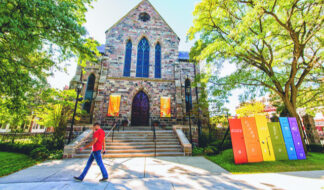So just what WERE those cowboys doing out there in the exciting, but lonely American West?
If we're to believe teacher and author Chris Packard, they were having sex, lots of sex – but not with women!
Much of what we know about the American cowboy comes initially from the popular press of the mid-to-late nineteenth century, and later, from the TV western. It was assumed that these hyper-masculine men saved their pent-up sexual tensions for the occasional trips into town where they dallied with the local "business women" who serviced their needs.
Polite society, of course, never gave such matters much thought. But many of us never bought into that theory. And obviously, neither did Packard – whose book, "Queer Cowboys and Other Erotic Male friendships in Nineteenth-Century American Literature," was released earlier this year.
"Before 1900, that is to say before the modern invention of the 'homosexual' as a social pariah, cowboy narratives represented male-male affection quite a bit more freely than Westerns produced after 1900, when male-male sex was classified as abnormal," he writes in his book's introduction. How those bonds worked to further the interests of Anglo-American males in the late nineteenth century, he later continues, is the subject of "Queer Cowboys."
To find evidence of erotic male friendships and gay sex among cowboys, Packard scours the work of such notable authors as James Fenimore Cooper ("The Leatherstocking Tales), Owen Wister ("The Virginian"), Claude Hartland ("The Story of a Life"), Frank Harris ("My Reminiscences as a Cowboy") and the writings of Walt Whitman and Mark Twain.
And what does he find? In some cases, no concrete proof that "stag dances" led to a romp in the hay, or that the "close companionship of men" meant anything more than two buddies who were simply the best of friends. (But if you read between the lines, you might come to a different conclusion!) In other cases, however, it's pretty clear cut what was happening under the stars or in the bunkhouse.
What dampers a reader's enthusiasm for this well-researched and generally interesting book is the author's style. One suspects it was written as a graduate thesis because, at times, it reads as such. And its suggested price, $55, might put it out of the reach of the casual reader.
But nevertheless, it's a fascinating subject that has long cried out for analysis. And Packard's book is a pretty darned good start!
Topics:
Entertainment









